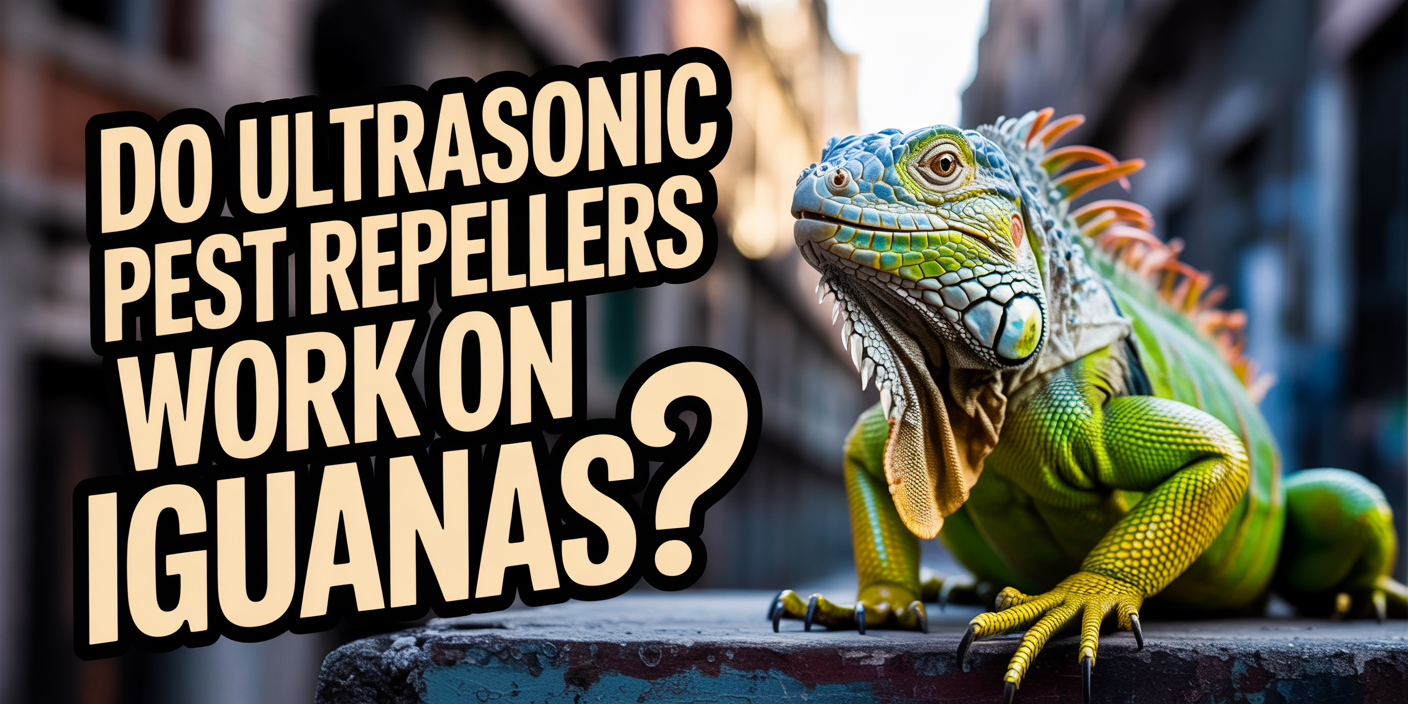“No. Ultrasonic pest repellers won’t move iguanas an inch. The reptiles can’t detect those high-frequency waves, so the gadgets end up as pricey yard ornaments instead of real deterrents.”
Iguanas have become more than just a backyard nuisance across Florida’s Treasure Coast. From munching on garden plants to digging under patios and damaging seawalls, these invasive reptiles are turning up in neighborhoods from Stuart to Port St. Lucie and beyond. As more homeowners search for easy, hands-off solutions, ultrasonic pest repellers often get tossed into shopping carts with the hope that a little sound wave might scare them off for good.
It’s a tempting idea: plug in a device, scare away the problem, and never deal with traps or wildlife calls. But do ultrasonic pest repellers actually work on iguanas—or is it just clever marketing? Before you spend money on tech that might not do what it claims, let’s break down how these devices work, how iguanas respond to them (if at all), and what truly gets results when you’re dealing with cold-blooded trespassers.
How Ultrasonic Pest Repellers Are Supposed to Work
What Ultrasonic Devices Do
Ultrasonic pest repellers emit high-frequency sound waves intended to deter pests. These frequencies are usually inaudible to humans but are meant to irritate small animals like rodents or insects. The goal is to make the environment uncomfortable enough that the pest leaves on its own—no chemicals, no traps, just sound.
Designed for the Wrong Species
Most of these devices are calibrated for pests with acute hearing, like mice or cockroaches—not reptiles. Iguanas don’t rely heavily on sound to sense danger or navigate their surroundings. Their behavior is driven more by sight, heat, and shelter availability than noise.
Why It Matters for Iguana Control
Because iguanas aren’t tuned in to high-frequency sounds, they’re unlikely to be affected by ultrasonic waves. In fact, many homeowners across the Treasure Coast have found that iguanas completely ignore these devices. While they might help with a rat problem, they won’t do much to scare off a sunbathing iguana.
Are Iguanas Affected by Ultrasonic Frequencies?
Iguanas simply aren’t wired to respond to ultrasonic frequencies. Their hearing range is limited compared to mammals, and they rely far more on vision, body temperature, and environmental cues than sound. That alone puts them outside the typical target zone for devices designed to annoy rodents or insects with high-pitched noise.
There’s also no solid scientific evidence supporting ultrasonic repellers as effective against reptiles. While these devices are sometimes marketed as all-purpose pest control tools, wildlife professionals and field researchers across Florida have consistently found that iguanas are unfazed by them. In many cases, the reptiles ignore the sound entirely or continue to return to the same spots regardless of the device’s presence.
More importantly, iguanas aren’t easily startled or sensitive to environmental changes. Once they find a place that feels safe—like a sunny seawall or shaded garden—they tend to settle in. A noise they can barely hear won’t be enough to make them leave, let alone stay away for good.
Real-World Effectiveness: Why Ultrasonic Devices Don’t Stop Iguanas
While ultrasonic pest repellers might seem like a futuristic fix, they consistently fall short when it comes to outdoor reptiles like iguanas. These devices are often tested under controlled conditions with specific pests in mind—usually rodents or insects. In real-world environments like the Treasure Coast, where factors like wind, humidity, and open space dilute sound waves, the results are even less reliable.
Homeowners who’ve tried ultrasonic repellents often find that iguanas simply ignore them. Some report the devices working for a day or two before the lizards return to their usual spots. This happens because iguanas either can’t hear the frequencies or they quickly become used to the sound. Once they realize there’s no threat, the noise becomes background static.
Even worse, relying on ultrasonic devices can give property owners a false sense of control. While the repeller hums in the background, iguanas continue digging up lawns, nesting under patios, or lounging on docks. Without active prevention and habitat changes, these pests stick around—and keep multiplying.
Treasure Coast Conditions That Make Repellers Even Less Effective
The unique environment along Florida’s Treasure Coast makes ultrasonic repellers even less effective than they already are. These devices rely on sound waves traveling through a relatively stable space, which just doesn’t happen outdoors. Between the coastal breeze, high humidity, and wide-open yards, any ultrasonic signal gets scattered before it can even reach an iguana—let alone bother it.
Many homes in areas like Port St. Lucie, Stuart, and Jensen Beach are built with large lawns, open patios, or direct access to canals and seawalls. That’s prime iguana territory and exactly the kind of space where ultrasonic repellers lose their punch. These devices weren’t made for use across open terrain or for animals that rely more on sun and shelter than sound.
On top of that, Treasure Coast properties tend to have a lot of ambient noise—waves, boat motors, wildlife—which further interferes with any high-frequency sound trying to make an impact. If you’re counting on ultrasonic tools to keep iguanas out of your yard in this kind of environment, you’re almost guaranteed to be disappointed.
What Actually Works to Repel Iguanas?
Physical Barriers That Block Access
One of the most effective ways to deter iguanas is by physically blocking their access. Installing mesh fencing around gardens, sealing crawl spaces, and wrapping trees or seawalls with metal guards prevents them from reaching their favorite sunning or nesting spots. These barriers send a strong signal that your property isn’t open for lounging.
Remove the Things That Attract Them
Iguanas are opportunistic and love a good buffet. If you’ve got fruit trees, uncovered compost, pet food left outside, or dense shrubs near your home, you’re basically rolling out the red carpet. Trimming vegetation, picking up fallen fruit, and clearing out clutter removes the comfort zones and food sources that make your yard appealing.
Use Motion or Visual Deterrents
While sound doesn’t scare them, movement and flashes of light can. Motion-activated sprinklers, reflective tape, spinning pinwheels, or even shiny mylar balloons may startle iguanas enough to make them think twice. These tools are especially helpful in gardens or along seawalls where other methods may not be practical.
Call in the Pros for Long-Term Results
For lasting protection, professional removal and exclusion are your best bets. Wildlife specialists like those at AAAC Wildlife Removal of Treasure Coast know how to safely trap and relocate iguanas—and more importantly, how to keep them from coming back. They’ll assess your property, close off entry points, and recommend a prevention plan that actually works in our coastal environment.
Why DIY Isn’t Enough: Hire Local Experts
Trying to handle an iguana infestation on your own often leads to frustration and wasted money. Ultrasonic gadgets, home remedies, and DIY traps might seem like a budget-friendly fix, but they rarely solve the root of the problem. Iguanas are persistent, and unless you understand their behavior, entry points, and nesting habits, they’ll keep coming back—especially in warm, iguana-friendly areas like the Treasure Coast.
That’s where licensed professionals come in. AAAC Wildlife Removal of Treasure Coast isn’t your average pest control crew. They’re trained specifically in wildlife behavior, Florida regulations, and humane trapping techniques. More importantly, they offer custom solutions tailored to the local climate and property layouts found in communities like Port St. Lucie, Jensen Beach, and Stuart. When you hire pros who know the terrain, you don’t just remove iguanas—you keep them gone for good.
Stop Guessing—Get Iguana Control That Actually Works
Ultrasonic repellers might sound high-tech, but they won’t stop iguanas from turning your backyard into their personal playground. If you’re tired of ineffective gadgets and recurring lizard problems, it’s time to bring in the professionals who know Florida wildlife inside and out.
At AAAC Wildlife Removal of Treasure Coast, we offer humane, science-based iguana control built for coastal neighborhoods like Stuart, Jensen Beach, and Port St. Lucie. Our licensed team will inspect your property, identify nesting areas, and implement a real plan to get rid of iguanas—and keep them out for good.
Call us today or request a quote online to schedule your inspection. We’ll give you straight answers, local expertise, and lasting protection—no gimmicks, no guesswork.




